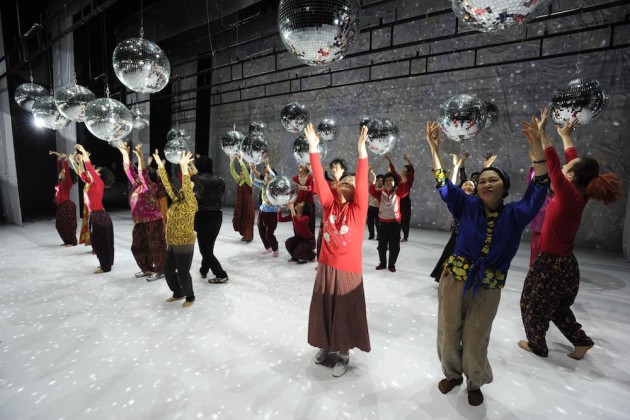Eun-Me Ahn, Dancing Grandmothers
Dunstan Playhouse. 25 October
Sidi Larbi Cherkaoui, Sutra
Dunstan Playhouse. 3 November
Director Joseph Mitchell has once again come up with an impressive dance program for the 2018 Adelaide OzAsia Festival. Among the highlights were Dancing Grandmothers, a quirky work from Korean choreographer Eun-Me Ahn, and Sidi Larbi Cherkaoui’s Sutra, both large ensemble works in which the choreographer also performs.
Dancing Grandmothers is billed as an homage to the "everyday women who founded modern Korea, many of whom are now grandmothers." In 2010 Eun-Me Ahn and her dancers toured Korea seeking out elderly women, and asked them to dance. Films of these women make up the middle section of the piece, showing elderly, obviously poor, women dancing in fish markets and hairdressers, at bus stops and in rice fields, on the side of the road where they sell vegetables, and so forth. They dance alone and together, they dance despite passers-by looking askance at them, their enjoyment infectious and moving.

The first section of the work, however, features no grandmothers: instead, a shaven-headed Eun-Me Ahn, in traditional dress, performs a slow stylized dance, as shaky videos of the Korean countryside are projected on the diorama. Nine dancers, dressed in an ever-changing array of bright floral patterned tops, pants, skirts and dresses designed by Eun-Me Ahn, eventually join her. Their initial movement is pedestrian, featuring much skipping, galloping, hopping and running, but this segues into acrobatic tumbling and nimble partner work. The dancers are superb, with the ability to shift seamlessly between contemporary, traditional, break dance and martial arts styles that seem to be the norm in many East Asian companies. But the sequence that ends this section, in which the dancers thrash frenziedly on the floor, getting up only to fall down again, is overlong, and it’s a relief when the filmed grandmothers make their appearance.
The final section integrates the young dancers with ten grandmothers on stage. The grandmothers initially move quite demurely, swaying from side to side and waving their arms, becoming more animated as the work progresses. The respect and love with which they are escorted on and off the stage by the dancers is a joy to behold. Various sequences featuring the whole cast ensue, including a dance with mops protruding out of the male dancers’ bottoms, line dances under psychedelic projections, a laughing party, and a music clip-like routine in which all the dancers are clad in watermelon pink unitards. The finale, featuring hordes of disco balls, becomes a joyful romp when Eun-Me Ahn invites the audience on stage for a giant multi-generational, multi-cultural party.

Where Dancing Grandmothers is a choreographer’s exploration of aspects of her own culture, Sutra charts a cross-cultural encounter. The work was made in 2008 by Sidi Larbi Cherkaoui after he spent some time with the kung fu Shaolin monks in Henan province in China, and has toured the world intermittently since then. Enamored of kung fu since childhood, Cherkaoui was also seeking to understand the relationship between the monk’s Buddhist ethos and their martial arts practice, and the work was born of his encounters with their austere lifestyle and disciplined daily practice.
Szymon Brzoska’s score, which comprises strings and percussion, creates a thoughtful, introspective mood. Antony Gormley’s design of wooden boxes for the twenty monks, plus a metal one for Cherkoaui, is pivotal to the piece. The monks’ manipulation of the boxes into a wall, a lotus flower, shelves, cells, beds, dominoes, etc., is intricately choreographed. The initial scene, in which Cherkaoui is seated on a box playing with miniature boxes with the youngest monk — a child of no more than seven, but whose movement is as precise as the adults — establishes the relationship that runs through the work. The literal translation of "sutra" is thread, and although other threads can be detected, the most obvious is the relationship between the middle-aged westerner and the child monk, who both guides and follows him through the box formations with a beguiling mixture of mastery and innocence.
For the most part the movement consists of kung fu rather than contemporary dance, with the muscular monks tumbling and leaping frenetically, and wielding staffs and other weapons in a number of fight sequences. Cherkoaui the choreographer is the outsider figure, moving in and out of the box formations, and manipulating miniature boxes as if he is in control of it all, yet manifestly unable to match the dazzling prowess of the monks he ostensibly directs. He loiters on the periphery, his occasional mimicry of their moves touchingly comical, but by the end he appears to have been assimilated into the troupe, punching and kicking with the rest.
Although dissimilar in mood and style, both these works are riveting, and attest to the staggering diversity of dance works being made in Asia and as Western responses to aspects of Asian culture.
Maggie Tonkin




